Answered: What is EDI in Healthcare?
What is EDI in healthcare? The answer is not so simple. Let’s look at the definition of EDI, how it works in healthcare, the different transaction types, and the benefits associated with it.

The global healthcare EDI market was worth $3.0 billion in 2020. Experts estimate it will reach $4.4 billion by 2025. That's a growth of 7.8%!
There are several reasons why the market is growing so much.
In the US, there are three main factors affecting the growth of the market…
- Increased adoption of healthcare EDI in claims
- Increased adoption of healthcare EDI in supply chain management
- Increased need for healthcare cost reductions
But where does EDI come from?
EDI first started back in the 1960s when there were more than 400 different standards. This caused conversion errors, poor interoperability, high IT costs, and security gaps.
Implementing EDI solved these issues by ensuring quick and smooth data transmission and interpretation.
But what is EDI in healthcare? The answer is not so simple. Let’s look at the definition of EDI, how it works in healthcare, the different transaction types, and the benefits associated with it.
What is EDI in Healthcare?
EDI stands for Electronic Data Interchange. It’s a secure way of transmitting data between healthcare practices, insurance agencies, government entities like Medicare, clearing houses, and patients.
When used in healthcare, EDI transmits information like…
- Coordination of benefits
- Claims status and information
- Insurance data
- Payment data and eligibility forms
In a nutshell, EDI is the automated transfer of data in a pre-defined format following data content rules. It creates a bridge between computer systems and applications.

Covered entities that exchange medical information electronically need to use uniform standards for all healthcare EDI transactions according to the HIPAA EDI Rule. This applies to health plans, clearinghouses, and care providers. HIPAA EDI compliance means organizations ASC X12 protocol when sending documents with PHI.
At this point, you may be asking yourself, “What is this protocol thing you just mentioned?”
ASC X12 protocol is the only acceptable format for HIPAA EDI transactions. This protocol ensures the security and accuracy of medical data. It requires all entities involved in the transmission of the documents to follow specific data specifications.
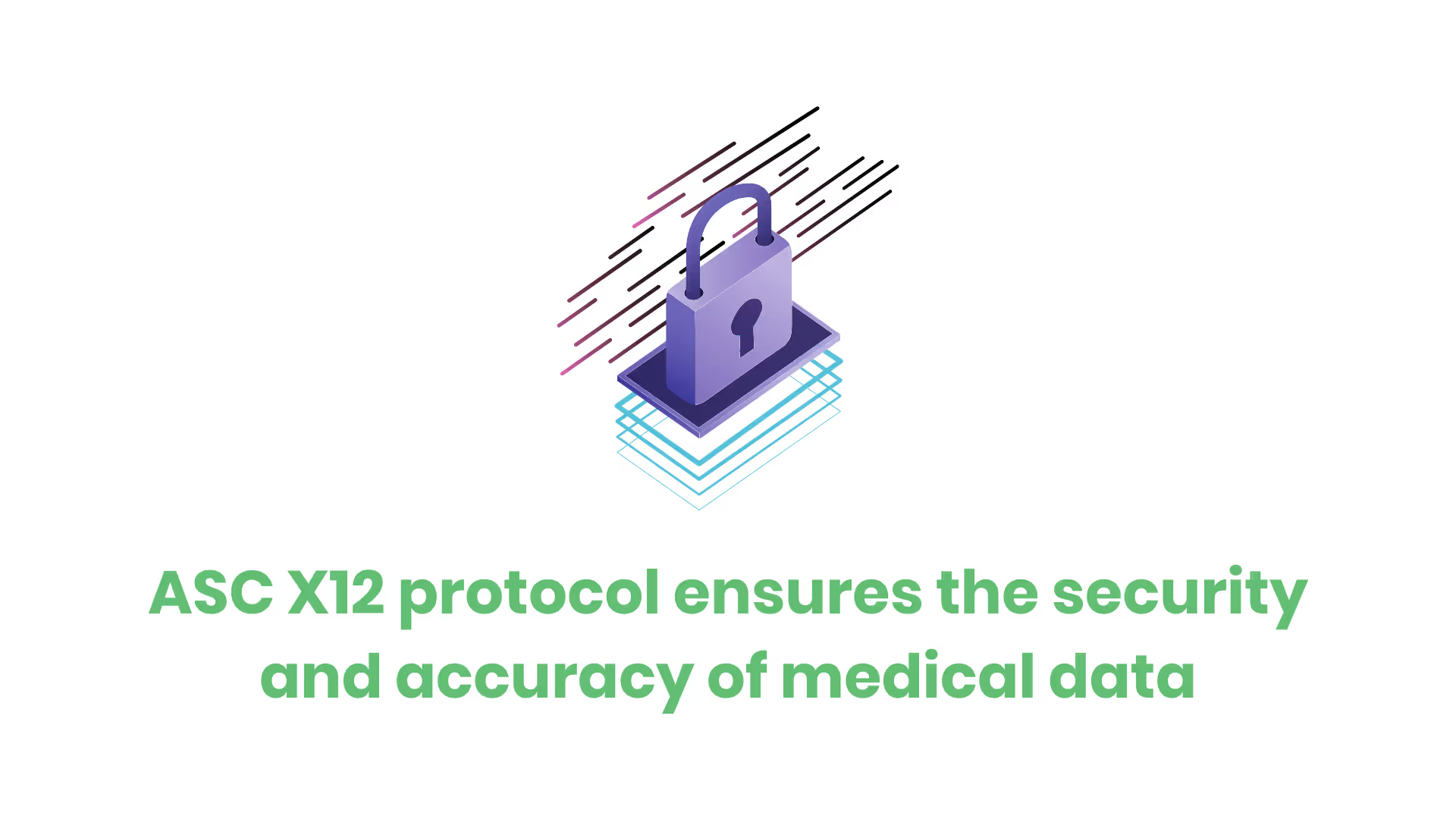
More specifically, before the transmission of the information, someone converts the data into computer language. Additionally, standardized codes get assigned to all the documentation sets.
To generate standardized EDI documents, and translate the documents into common business formats, organizations use HIPAA EDI software solutions.
How Healthcare EDI Works
Healthcare EDI transactions usually happen in six unique steps.
These steps are…
- The medical provider initiates an inquiry by supplying specific data
- The specified data could be member ID numbers or date of birth
- The inquiry goes to a clearinghouse contracted by the provider
- Prior to submission, the clearinghouse scrubs the claim for any errors and notifies the provider of the same
- The provider tells the clearinghouse to send the inquiry to the payer
- The payer could be the insurance company, a government entity, or the patient
- The payer responds to the clearinghouse
- The clearinghouse sends the response to the medical provider
All involved parties send information using codes outlined in ASC X12, as mentioned before. To recap, ASC X12 is the general standard that governs all EDI transaction codes, including electronic healthcare transactions.
Healthcare EDI Transaction Types
EDI in healthcare offers a variety of transaction sets. These sets have a variety of uses, allowing healthcare organizations to send different kinds of information.
The sets cover EDI transactions like…
- Healthcare claim
- Healthcare claim payment/advice
- Benefits enrollment and maintenance
- Healthcare eligibility/benefit inquiry
- Healthcare eligibility/benefit response
- Healthcare service review information
In general, organizations in the healthcare space use ten types of HIPAA EDI transactions. Let’s go over what these transactions are and what they look like.
Healthcare Claim Transaction (836)
Healthcare organizations use EDI 836 for submitting healthcare claim billing information, encounter information, or both.
This transaction does not apply to retail pharmacy claims. Those are usually sent from healthcare providers to payers. This happens either directly or through intermediary billers and claims clearinghouses.
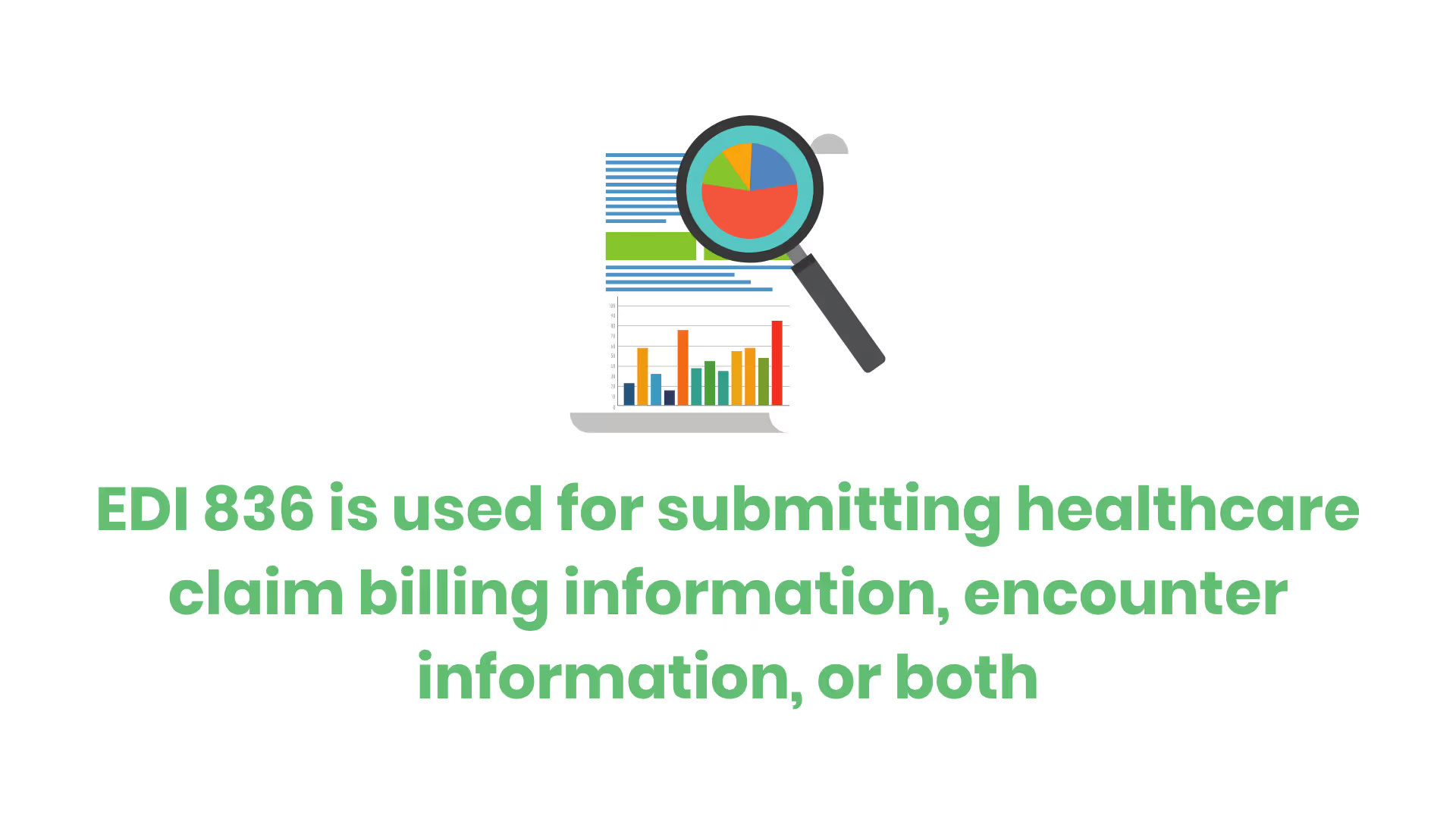
Retail Pharmacy Claim Transaction
Retail pharmacy claim transactions allow healthcare professionals and regulatory agencies to submit retail pharmacy claims. This type of EDI healthcare transaction lets different entities send claims for retail pharmacy services and billing payment information to payers.
Healthcare Claim Payment/Advice Transaction (835)
Insurers use this to make payments and send Explanation of Benefits (EOB) remittance advice. They will send this information using this transaction type to healthcare providers.
Benefits Enrollment and Maintenance Set (834)
Employers, unions, government agencies, insurance agencies, associations, and healthcare organizations use transaction 834 to pay claims. This type of translation aims to enroll members in a healthcare benefit plan.
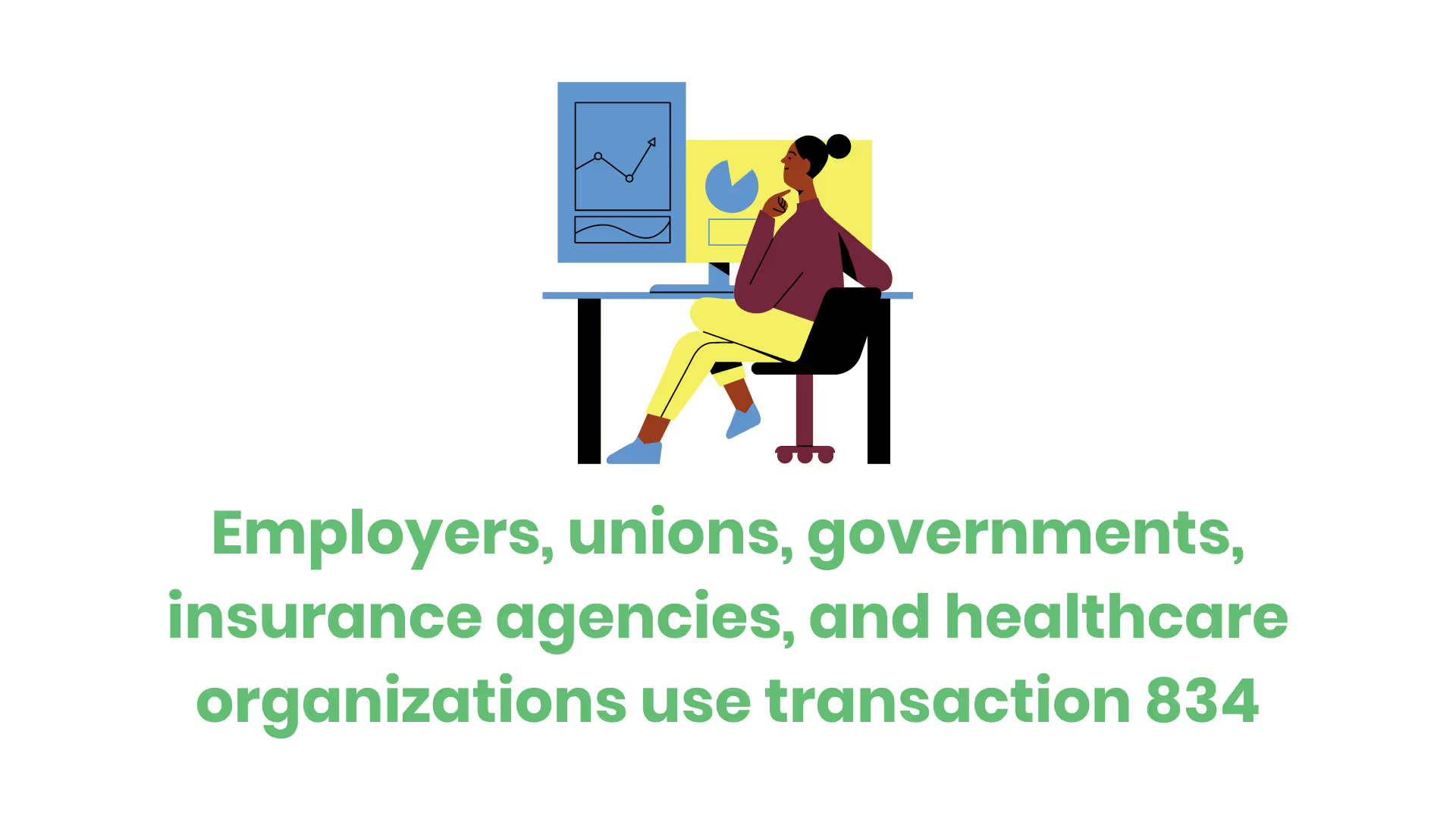
Payroll Deducted and Other Group Premium Payments for Insurance Products (820)
Transaction 820 serves to make premium payments for insurance products. Healthcare institutions use these transactions to send information to financial organizations.
Healthcare Eligibility/Benefit Inquiry (270)
Healthcare institutions use transaction set 270 to send inquiries for healthcare benefits and subscriber eligibility. These transaction sets get sent to financial institutions and government agencies.
Healthcare Eligbility/Benefit Response (271)
The main purpose of this transaction set is to respond to request inquiries about healthcare benefits and eligibility associated with a subscriber or dependent.
Like transaction 270, healthcare institutions use transaction 271 to send information to financial institutions and government agencies.
Healthcare Claim Status Request (276)
Healthcare providers use transaction 276 to request or verify the status of healthcare previously submitted to a payer.
For example, a payer could be an insurance company.
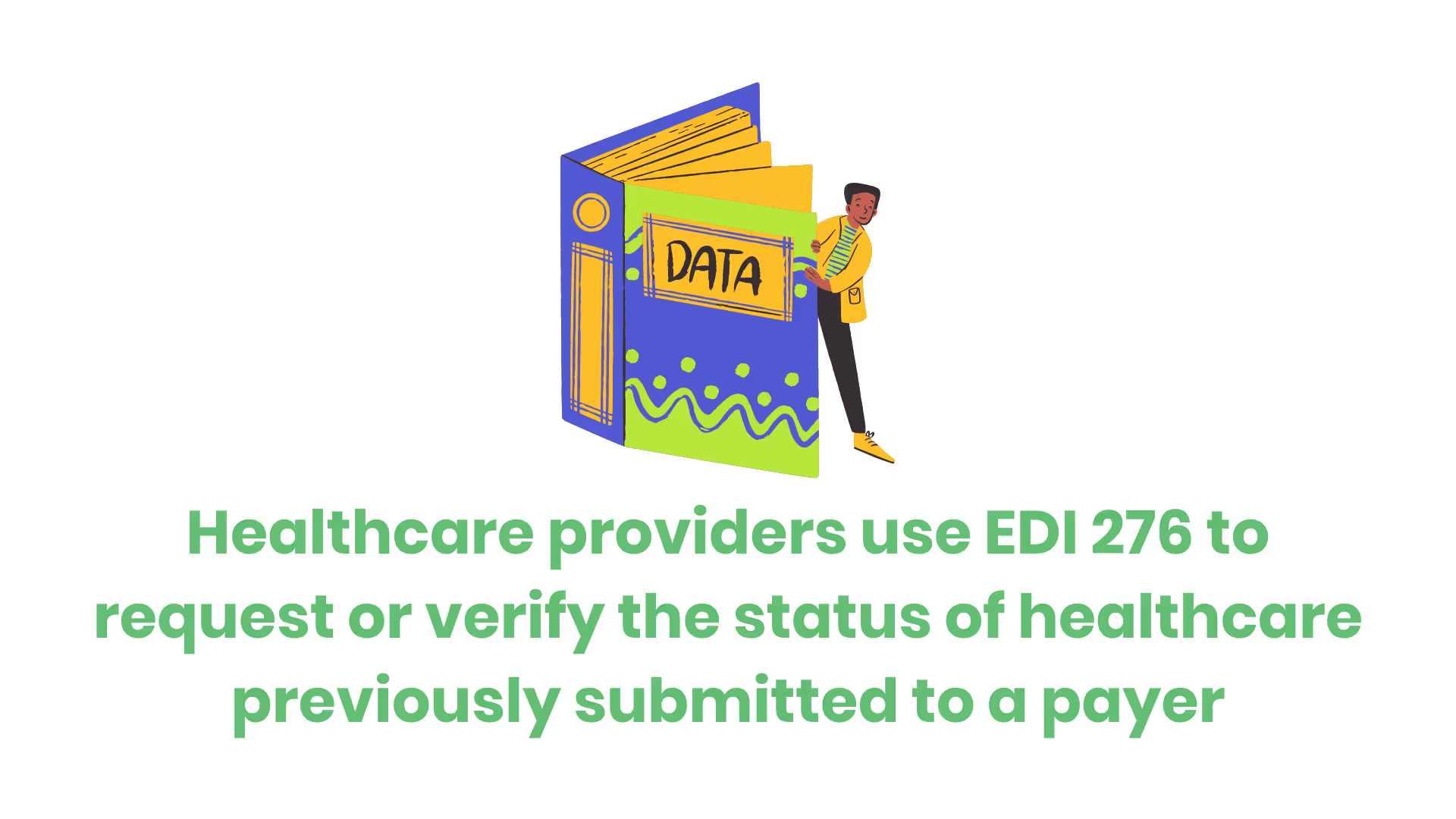
Healthcare Claim Status Notification (277)
Transaction 277 serves for reporting on the status of claims previously submitted by providers. Healthcare payers and insurance companies are the ones who use this type of transaction.
Healthcare Service Review Information (278)
Hospitals use transaction 278 to request authorization from a payer, such as an insurance company.
The Benefits of EDI in Healthcare
There are five main benefits of using EDI in the healthcare space…
- Standardization
- Cost savings
- Security
- Improved productivity
- Faster processing
Let’s first talk about standardization. The main intention of using EDI in the healthcare space was to establish national and global standards. EDI helps keep healthcare organizations organized, compliant, accurate, and efficient.

EDI in healthcare also helps reduce costs. Using EDI to standardize transactions can lower the handling costs of processing documents. After all, it helps end the paper trail, and digital transactions are cheaper than paper ones.
Based on government estimates, EDI can save...
- $1 per claim for health plans
- $1.49 for physicians
- $0.86 for hospitals
- $0.83 for others
EDI in healthcare also facilitates additional security. It provides the secure transfer of information between healthcare providers, payers, and insurers. EDI enables secure data transmission, as mandated by HIPAA laws.
Using EDI also improves productivity. It enables a high level of accuracy, efficiency, and speed. Because EDI’s way of doing things uses minimal human intervention, there are fewer errors. These errors include manual data errors, shipping errors, billing address errors, and more. In turn, this means fewer rework requests.
But, it’s not foolproof.
If you’re in the healthcare space you’re all too familiar with claim denials coming back from payers. However, EDI does also make it easier to send appeal letters and denial resubmissions.
Furthermore, transactions with multiple buyers can happen at once, improving productivity further.
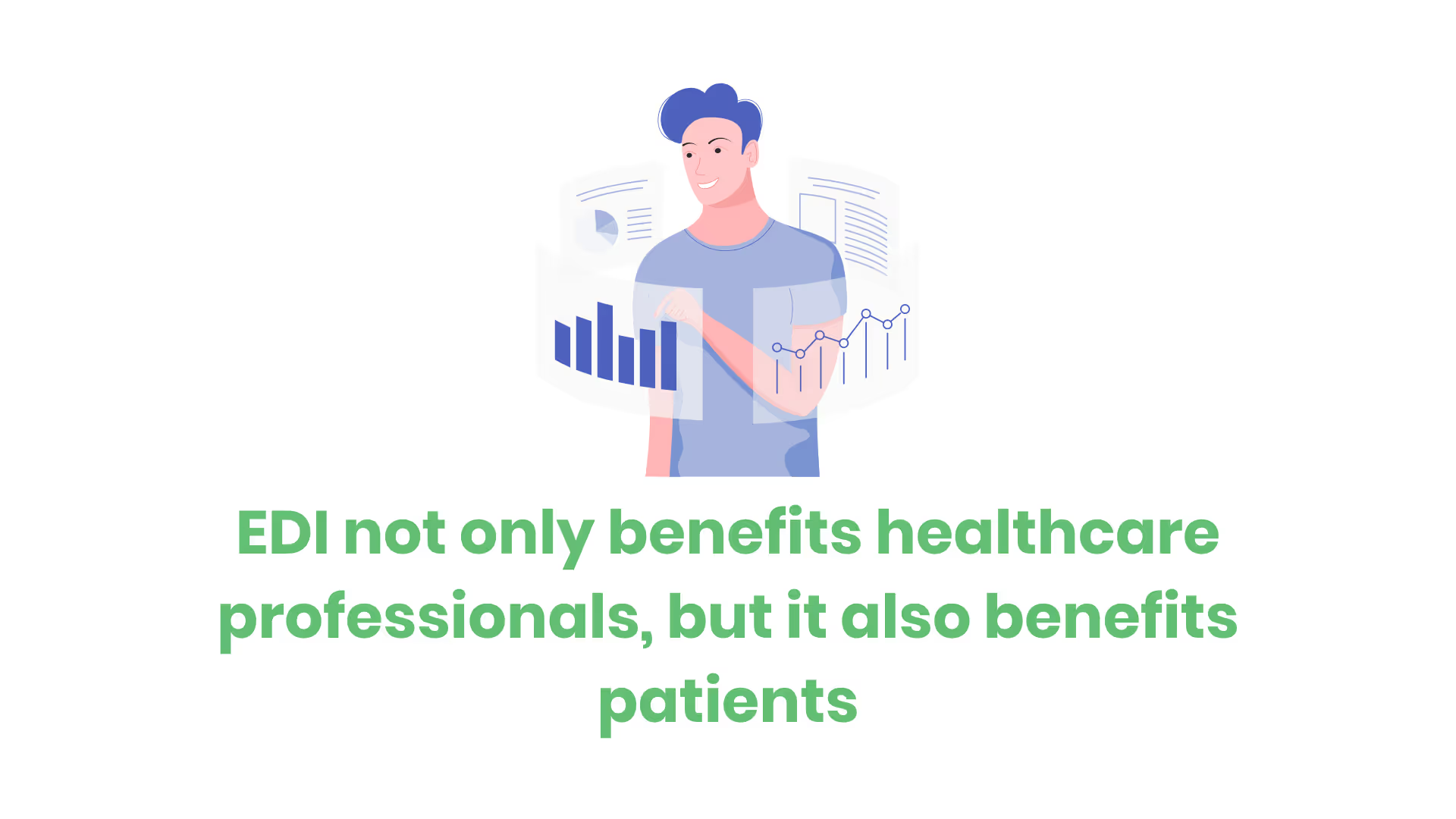
Lastly, one of the benefits of using EDI in healthcare is faster processing. EDI not only benefits healthcare professionals, but it also benefits patients. One of the reasons for HIPAA’s creation is to give patients access to their healthcare information. EDI transactions are beneficial to HIPAA’s mission because it speeds up the claims and benefits process.
Conclusion
The healthcare industry is one of many that processes an enormous amount of documents.
These documents include…
- Patient medical records
- Health insurance reimbursements
- Healthcare claims
Using paper is cumbersome, inefficient, and expensive. That’s why the government responded to the situation with the creation of EDI.
EDI is very complicated and confusing. But at the end of the day, it helps simplify the process of organizing and sending documents from a healthcare provider to someone else.
Emphasize your product's unique features or benefits to differentiate it from competitors
In nec dictum adipiscing pharetra enim etiam scelerisque dolor purus ipsum egestas cursus vulputate arcu egestas ut eu sed mollis consectetur mattis pharetra curabitur et maecenas in mattis fames consectetur ipsum quis risus mauris aliquam ornare nisl purus at ipsum nulla accumsan consectetur vestibulum suspendisse aliquam condimentum scelerisque lacinia pellentesque vestibulum condimentum turpis ligula pharetra dictum sapien facilisis sapien at sagittis et cursus congue.
- Pharetra curabitur et maecenas in mattis fames consectetur ipsum quis risus.
- Justo urna nisi auctor consequat consectetur dolor lectus blandit.
- Eget egestas volutpat lacinia vestibulum vitae mattis hendrerit.
- Ornare elit odio tellus orci bibendum dictum id sem congue enim amet diam.
Incorporate statistics or specific numbers to highlight the effectiveness or popularity of your offering
Convallis pellentesque ullamcorper sapien sed tristique fermentum proin amet quam tincidunt feugiat vitae neque quisque odio ut pellentesque ac mauris eget lectus. Pretium arcu turpis lacus sapien sit at eu sapien duis magna nunc nibh nam non ut nibh ultrices ultrices elementum egestas enim nisl sed cursus pellentesque sit dignissim enim euismod sit et convallis sed pelis viverra quam at nisl sit pharetra enim nisl nec vestibulum posuere in volutpat sed blandit neque risus.

Use time-sensitive language to encourage immediate action, such as "Limited Time Offer
Feugiat vitae neque quisque odio ut pellentesque ac mauris eget lectus. Pretium arcu turpis lacus sapien sit at eu sapien duis magna nunc nibh nam non ut nibh ultrices ultrices elementum egestas enim nisl sed cursus pellentesque sit dignissim enim euismod sit et convallis sed pelis viverra quam at nisl sit pharetra enim nisl nec vestibulum posuere in volutpat sed blandit neque risus.
- Pharetra curabitur et maecenas in mattis fames consectetur ipsum quis risus.
- Justo urna nisi auctor consequat consectetur dolor lectus blandit.
- Eget egestas volutpat lacinia vestibulum vitae mattis hendrerit.
- Ornare elit odio tellus orci bibendum dictum id sem congue enim amet diam.
Address customer pain points directly by showing how your product solves their problems
Feugiat vitae neque quisque odio ut pellentesque ac mauris eget lectus. Pretium arcu turpis lacus sapien sit at eu sapien duis magna nunc nibh nam non ut nibh ultrices ultrices elementum egestas enim nisl sed cursus pellentesque sit dignissim enim euismod sit et convallis sed pelis viverra quam at nisl sit pharetra enim nisl nec vestibulum posuere in volutpat sed blandit neque risus.
Vel etiam vel amet aenean eget in habitasse nunc duis tellus sem turpis risus aliquam ac volutpat tellus eu faucibus ullamcorper.
Tailor titles to your ideal customer segment using phrases like "Designed for Busy Professionals
Sed pretium id nibh id sit felis vitae volutpat volutpat adipiscing at sodales neque lectus mi phasellus commodo at elit suspendisse ornare faucibus lectus purus viverra in nec aliquet commodo et sed sed nisi tempor mi pellentesque arcu viverra pretium duis enim vulputate dignissim etiam ultrices vitae neque urna proin nibh diam turpis augue lacus.



![[ANSWERED] What is a Long-Term Care (LTC) Pharmacy](https://cdn.prod.website-files.com/67e2b8210878abcba6f91ae6/68d687806a075a1cf64659b0_WhatisLongTermCarePharmacy_925.avif)
